Upgrade Shop – Durable and Stylish Barber Chairs for Budget
Upgrading barber shop is an essential step toward enhancing the customer experience and elevating your brand’s image, and one of the most impactful changes you can make is investing in durable and stylish barber chairs. The right chairs not only provide comfort for your clients but also serve as a statement piece that reflects your shop’s aesthetic and professionalism. When selecting barber chairs, it is crucial to consider various factors, including durability, style, and budget. Durable barber chairs are designed to withstand the rigors of daily use, ensuring they maintain their appearance and functionality over time. Look for chairs constructed from high-quality materials such as heavy-duty vinyl, which is resistant to tears and stains, and robust metal frames that provide stability and longevity. Additionally, features like adjustable height and reclining options can enhance the comfort level for clients, making their experience more enjoyable.

On the styling front, the choices are endless. Whether your shop leans toward a modern, sleek design or a vintage, classic vibe, you can find chairs that complement your overall aesthetic. Chairs with bold colors or unique designs can serve as eye-catching focal points, while more subdued options can convey elegance and sophistication. There is also the option to customize your chairs with your shop’s logo or branding elements, which can help create a cohesive and professional atmosphere. Another important aspect is budget consideration. Fortunately, the market offers a wide range to fit every budget without compromising quality. From affordable yet stylish options for new barbershops to high-end, luxurious models for established salons, you can find something that meets your financial constraints. It is essential to strike a balance between cost and quality; investing in higher-quality chairs.
It might seem like a larger upfront expense but can save you money in the long run by reducing the need for frequent replacements. Moreover, when upgrading your barber chairs, think about the overall layout and flow of your shop. The arrangement of your Barber Chair can significantly impact the workflow of your barbers and the overall ambiance of the space. Ensure that there is enough space between chairs to allow for easy movement and to provide clients with a sense of privacy and comfort. It is also beneficial to consider the aesthetic appeal of your waiting area. Comfortable, stylish seating for waiting clients can enhance their experience and make your shop feel more inviting. Additionally, do not forget about maintenance; choose chairs that are easy to clean and maintain, allowing you to keep your shop looking fresh and professional.






